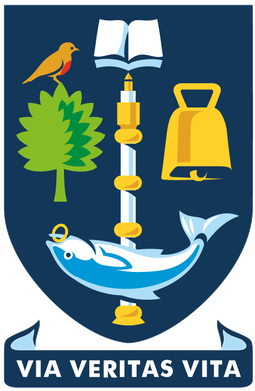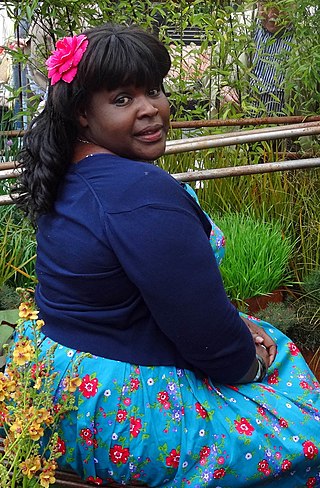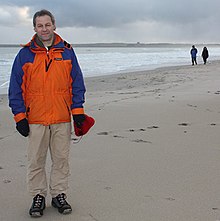
The University of Glasgow is a public research university in Glasgow, Scotland. Founded by papal bull in 1451 [O.S. 1450], it is the fourth-oldest university in the English-speaking world and one of Scotland's four ancient universities. Along with the universities of Edinburgh, Aberdeen, and St Andrews, the university was part of the Scottish Enlightenment during the 18th century.

John Logie BairdFRSE was a Scottish inventor, electrical engineer, and innovator who demonstrated the world's first live working television system on 26 January 1926. He went on to invent the first publicly demonstrated colour television system and the first viable purely electronic colour television picture tube.

Helensburgh is an affluent coastal town on the north side of the Firth of Clyde in Scotland, situated at the mouth of the Gareloch. Historically in Dunbartonshire, it became part of Argyll and Bute following local government reorganisation in 1996.
Scanning probe microscopy (SPM) is a branch of microscopy that forms images of surfaces using a physical probe that scans the specimen. SPM was founded in 1981, with the invention of the scanning tunneling microscope, an instrument for imaging surfaces at the atomic level. The first successful scanning tunneling microscope experiment was done by Gerd Binnig and Heinrich Rohrer. The key to their success was using a feedback loop to regulate gap distance between the sample and the probe.
Ultra-high vacuum (UHV) is the vacuum regime characterised by pressures lower than about 100 nanopascals. UHV conditions are created by pumping the gas out of a UHV chamber. At these low pressures the mean free path of a gas molecule is greater than approximately 40 km, so the gas is in free molecular flow, and gas molecules will collide with the chamber walls many times before colliding with each other. Almost all molecular interactions therefore take place on various surfaces in the chamber.

Kelvin probe force microscopy (KPFM), also known as surface potential microscopy, is a noncontact variant of atomic force microscopy (AFM). By raster scanning in the x,y plane the work function of the sample can be locally mapped for correlation with sample features. When there is little or no magnification, this approach can be described as using a scanning Kelvin probe (SKP). These techniques are predominantly used to measure corrosion and coatings.
An ion pump is a type of vacuum pump which operates by sputtering a metal getter. Under ideal conditions, ion pumps are capable of reaching pressures as low as 10−11 mbar. An ion pump first ionizes gas within the vessel it is attached to and employs a strong electrical potential, typically 3–7 kV, which accelerates the ions into a solid electrode. Small bits of the electrode are sputtered into the chamber. Gasses are trapped by a combination of chemical reactions with the surface of the highly-reactive sputtered material, and being physically trapped underneath that material.
The School of Chemistry is a school of the University of Edinburgh, in Scotland. In the 2008 Research Assessment Exercise (RAE) the school was ranked sixth in the UK.

Michael Lawrence KleinNAS is Laura H. Carnell Professor of Science and Director of the Institute for Computational Molecular Science in the College of Science and Technology at Temple University in Philadelphia, USA. He was previously the Hepburn Professor of Physical Science in the Center for Molecular Modeling at the University of Pennsylvania. Currently, he serves as the Dean of the College of Science and Technology and has since 2013.

Margaret Ebunoluwa Aderin-Pocock is a British space scientist and science educator. She is an honorary research associate of University College London's Department of Physics and Astronomy, and has been the chancellor of the University of Leicester since February 2023. Since February 2014, she has co-presented the long-running astronomy television programme The Sky at Night with Chris Lintott. In 2020 she was awarded the Institute of Physics William Thomson, Lord Kelvin Medal and Prize for her public engagement in physics. She is the first black woman to win a gold medal in the Physics News Award. She has also earned the title of the president-elect of the British Science Association.

Iain Donald Campbell was a Scottish biophysicist and academic. He was Professor of Structural Biology at the University of Oxford from 1992 to 2009.
The Katharine Burr Blodgett Medal and Prize is a gold medal awarded annually by the Institute of Physics to "recognise contributions to the organisation or application of physics in an industrial or commercial context." The medal is accompanied by a prize of £1000.
The Caithness International Science Festival is an event which is held annually in Caithness, Scotland. The science festival features talks, tours and exhibitions for in locations around Wick, Thurso and rural Caithness. It is aimed at children, families and adults and has been held each March since 2003.

Gerald Leroy Fowler was a veteran of World War II, the lead technician in the Field Emission laboratory at the Pennsylvania State University and was a master technician in the Surface Science division at Sandia National Laboratories in Albuquerque, New Mexico. He was the author or co-authored of nine technical publications in refereed journals.
KP Technology Ltd was established in 2000 as an international multidisciplinary engineering, science and technology research company offering services particularly in the research, material, energy, defence, environment, corrosion and medical sectors. It specialises in Kelvin probes, surface photovoltage and air photoemission.

Sheila Rowan is a Scottish physicist and academic, who is Professor of Physics and Astronomy at the University of Glasgow in Scotland, and director of its Institute for Gravitational Research since 2009. She is known for her work in advancing the detection of gravitation waves. In 2016, Rowan was appointed the (part-time) Chief Scientific Advisor to the Scottish Government.
Moira Mary Jardine is a British astrophysicist with an interest in young stars, particularly the structure of their magnetic fields and coronae, and the mechanisms by which they interact with their disks and planets. She was promoted to a Personal Chair in 2012, making her the first female professor of Physics at the University of St Andrews.

The Department of Materials is responsible for the teaching and research in materials science and engineering at Imperial College London, occupying the Royal School of Mines and Bessemer buildings on the South Kensington campus. It can trace its origins back to the metallurgy department of the Government School of Mines and Science applied to the Arts, founded in 1851.
Rebecca Jane Lunn is a Professor and Head of the Centre for Ground Engineering and Energy Geosciences at the University of Strathclyde. I










